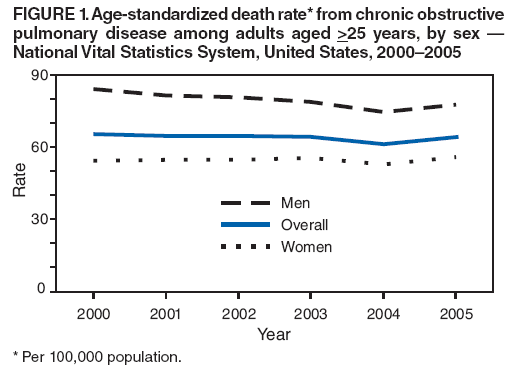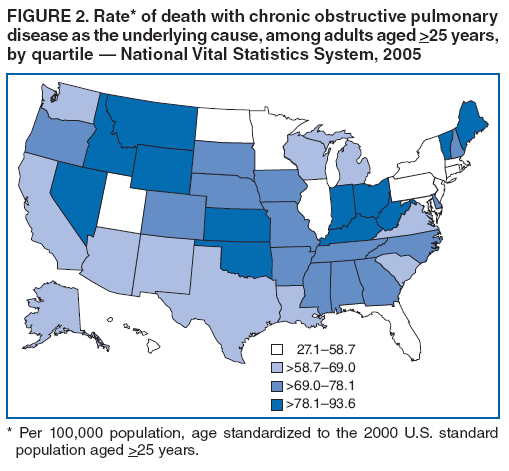 |
|
|
|
|
|
|
| ||||||||||
|
|
|
|
|
|
|
||||
| ||||||||||
|
|
|
|
|
Persons using assistive technology might not be able to fully access information in this file. For assistance, please send e-mail to: mmwrq@cdc.gov. Type 508 Accommodation and the title of the report in the subject line of e-mail. Deaths from Chronic Obstructive Pulmonary Disease --- United States, 2000--2005Chronic obstructive pulmonary disease (COPD) is a heterogeneous group of slowly progressive diseases characterized by airflow obstruction that interferes with normal breathing (1). In 2005, approximately one in 20 deaths in the United States had COPD as the underlying cause. Smoking is estimated to be responsible for at least 75% of COPD deaths (2). Excess health-care expenditures are estimated at nearly $6,000 annually for every COPD patient in the United States (3). To update national estimates of deaths from COPD for the period 2000--2005 (the most recent years for which data are available), CDC analyzed data from the National Vital Statistics System (NVSS). Results of that analysis indicated that an estimated 126,005 deaths of persons aged >25 years occurred in 2005 with COPD as the underlying cause, an increase of 8% from 116,494 deaths in 2000. Age-standardized COPD mortality rates remained fairly stable during the period overall but decreased among men and increased among women. To decrease the number and rate of COPD deaths, public health programs should continue efforts to reduce all personal exposure to 1) tobacco smoke, including passive smoke exposure; 2) occupational dusts and chemicals; and 3) other indoor and outdoor air pollutants linked to COPD (3). Once COPD is diagnosed, chronic disease management programs should work to prevent further deterioration in lung function and reduce COPD mortality (4). The numbers of deaths for which COPD was the underlying cause* and population estimates for calculation of rates were obtained from the CDC Wonder compressed mortality database of the National Vital Statistics System. International Classification of Diseases, Tenth Revision (ICD-10) codes were used to identify cases of COPD.§ Annual age-, sex-, and race-specific rates (per 100,000 population) of death from COPD during 2000--2005 were computed by dividing the number of COPD deaths by midyear population estimates, using the 2000 U.S. standard population aged >25 years for direct age standardization. Rate calculations were restricted to adults aged >25 years because this group accounted for 99.9% of all COPD deaths. During 2000--2005, COPD was the underlying cause of death for 718,077 persons overall aged >25 years in the United States. The number of deaths from COPD increased from 116,494 in 2000 to 121,267 in 2003, decreased to 117,134 in 2004, and increased to 126,005 in 2005 (Table 1). Age-standardized death rates per 100,000 population decreased during 2000--2004; the rate in 2005 was similar to that for 2003. From 2000 to 2005, the annual number of deaths from COPD increased 5% among men (Table 1), and the number of deaths was higher in 2005 than in 2004. The death rate for men declined during 2000--2005 and was lower in 2004 than in 2005 (Figure 1). Among women, the annual number of deaths increased 11% from 2000 to 2005 and was lower in 2005 than in 2004. The death rate for women increased from 2000 to 2003, decreased in 2004, and increased in 2005 (Figure 1). The death rate was higher for men compared with the rate for women in each year, but the number of deaths was greater for women. For each year during 2000--2005, COPD mortality rates were higher among whites than among blacks or persons of all other races. During this period, the rate for blacks remained stable, except for 2004, when the rate was lower. In 2005, the death rate among white men was 80.2 (95% confidence interval [CI] = 79.5--80.9) compared with 63.8 (CI = 61.8--65.8) among black men, 60.3 (CI = 59.8--60.8) among white women, and 29.9 (CI = 28.9--30.9) among black women. By state, in 2005, age-standardized death rates from COPD for adults aged >25 years ranged from 27.1 per 100,000 in Hawaii to 93.6 per 100,000 population in Oklahoma. States with COPD death rates in the highest quartile were as follows: Idaho, Indiana, Kansas, Kentucky, Maine, Montana, Nevada, Ohio, Oklahoma, Vermont, West Virginia, and Wyoming (Figure 2). Among adults aged 25--64 years, rates ranged from 6.2 (Massachusetts and New Jersey) to 19.2 (Oklahoma) per 100,000 population for men and from 3.8 (New Jersey) to 16.5 (West Virginia) in women (Table 2). Among adults aged >65 years, rates ranged from 169.0 (Hawaii) to 540.4 (Vermont) per 100,000 population in men and from 94.7 (Hawaii) to 394.9 (Nevada) in women. Reported by: DW Brown, JB Croft, PhD, KJ Greenlund, PhD, WH Giles, MD, Div of Adult and Community Health, National Center for Chronic Disease Prevention and Health Promotion, CDC. Editorial Note:From 1980 to 2000, the COPD death rate in the United States among women aged >25 years increased from 20.1 to 56.7 per 100,000 population, while the rate for men aged >25 years increased from 73.0 to 82.6 per 100,000 population (5). The findings in this report indicate that, during 2000--2005, the overall age-standardized mortality rate from COPD in the United States was fairly stable, but the absolute number of COPD deaths increased 8% from 2000 to 2005. During the period, more women than men died from COPD, and death rates from COPD increased among women while rates decreased among men. The difference in mortality rates between men and women might reflect a delay in mortality related to smoking exposure among women relative to men in the United States in the second half of the 20th century (6). In addition, women might be more susceptible to COPD as a result of sex differences in xenobiotic metabolism, hormones that modify detoxifying enzymes, airway inflammation and responsiveness, and particle deposition (7). The changes in death rates observed in 2004 and 2005 for men, women, and overall suggest a need for continued monitoring to assess whether changes are trending in a more favorable or less favorable pattern. State-specific variations in COPD mortality might reflect differences in smoking histories and/or differences in other exposures such as occupational exposure across states. Occupational exposure to dust, fumes, and gases accounts for approximately 15% of COPD cases (8). The findings in this report are subject to at least two limitations. First, data are subject to misclassification of race both in the population census and on death certificates, which might result in overreporting or underreporting of deaths or rates for certain racial groups. Second, data on underlying cause of death might be subject to errors in diagnosis and reporting on the death certificate. Public health programs that focus on reducing total personal exposure to tobacco smoke, occupational dusts and chemicals, and other indoor and outdoor air pollutants are critically important (4). Although current evidence does not support population screening using office spirometry to detect COPD (9), patients should be identified and treated as early as possible in the course of the disease. Disease prevention is the ultimate goal, but once COPD has been diagnosed, effective management should be aimed at relieving symptoms; preventing disease progression; improving exercise tolerance, daily activity, and health status; preventing and treating complications and exacerbations; and reducing mortality (4,9). No treatment has been shown to effectively modify the rate of decline in lung function; however, evidence supports the use of bronchodilators as the primary pharmacologic therapy to prevent and control symptoms, reduce the frequency and severity of acute exacerbations, and improve quality of life (9). Physicians should be aware of the availability of clinical practice guidelines for the diagnosis and management of COPD and guidelines on smoking cessation among COPD patients. COPD represents an important public health challenge that is both preventable and treatable. Globally, the COPD burden is projected to increase in coming decades because of continued exposure to COPD risk factors and aging of the population (10). Further efforts to improve public recognition of COPD as a public health problem and to increase awareness of COPD symptoms are needed. References
* Underlying cause is defined by the World Health Organization as the disease or injury that initiated the train of morbid events leading directly to death or the circumstances of the accident or violence that produced the fatal injury. The underlying cause is selected from the conditions entered by the physician in the cause-of-death section of the death certificate. When more than one cause or condition is entered by the physician, the underlying cause is determined by the sequence of conditions on the certificate, provisions of the International Classification of Diseases, and associated selection rules and modifications. Additional information is available at http://www.cdc.gov/nchs/data/nvsr/nvsr49/nvsr49_08.pdf. Available at http://wonder.cdc.gov/mortsql.html. § ICD-10 codes used were J40 (bronchitis not specified as acute or chronic), J41 (simple and mucopurulent chronic bronchitis), J42 (unspecified chronic bronchitis), J43 (emphysema), and J44 (other chronic obstructive pulmonary disease)(2). Available at http://www.cdc.gov/nchs/about/major/dvs/icd10des.htm. Table 1 Return to top. Figure 1  Return to top. Table 2  Return to top. Figure 2  Return to top.
All MMWR HTML versions of articles are electronic conversions from typeset documents. This conversion might result in character translation or format errors in the HTML version. Users are referred to the electronic PDF version (http://www.cdc.gov/mmwr) and/or the original MMWR paper copy for printable versions of official text, figures, and tables. An original paper copy of this issue can be obtained from the Superintendent of Documents, U.S. Government Printing Office (GPO), Washington, DC 20402-9371; telephone: (202) 512-1800. Contact GPO for current prices. **Questions or messages regarding errors in formatting should be addressed to mmwrq@cdc.gov.Date last reviewed: 11/13/2008 |
|||||||||
|